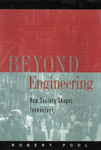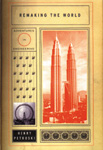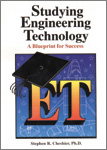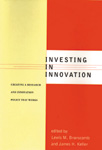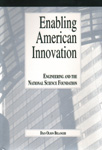Booknotes
Toward a New Research Paradigm
Pasteur’s Quadrant: Basic Science and Technological Innovation
By Donald E. Stokes. Brookings
Institution Press; 1997; 180 pp., $14.95.
Reviewed by Albert L. McHenry
Click on the book cover to order from Amazon.com
In Pasteur’s Quadrant, Donald E. Stokes brings the recent history of our current research paradigm into sharp focus, explaining the forces that drive current institutional constructs and our behavioral responses. By describing the influence of the relationship between government and the scientific community that has evolved over the past 50 years, Stokes challenges us to seek a more relevant research model.
Stokes, who received his Ph.D. from Yale University, was dean emeritus of Princeton University’s Woodrow Wilson School of Public and International Affairs when he died in 1997. He served as dean of the school for 18 years, from 1974 to 1992. Over a distinguished academic career, he also taught at Yale University, the University of Michigan, Oxford University, University of the West Indies, and the Australian National University. His most recent research examined the relationship between basic science and technological innovation. To this research topic, Stokes brought his vast experience in analyzing the influence of politics on social change. Pasteur’s Quadrant is the result of his findings and conclusions.
The book, which takes the form of a standard sociological research report, begins with a review of the seminal literature that helped to establish the modern research paradigm. Stokes focuses on Sciences, the Endless Frontier, an extremely influential federal report released by Vannevar Bush in his role as President Franklin Roosevelt’s director of the Office of Scientific Research and Development. Bush’s report declared the existence of a dichotomy between basic and applied science, a belief that endures as the basis for the current national research paradigm. Stokes challenges Bush’s view, promoting instead a recasting of the research relationship between the scientific community and government through a careful analysis of the variations in scientific research motives.
Stokes begins his primary analysis by tearing asunder the wall between understanding-inspired basic research and use-inspired applied research. Applying the linear understanding/use model to Louis Pasteur, Stokes determined that in this model Pasteur resides at zero—precisely in the middle. Pasteur’s equal commitments “to understand the microbiological processes he discovered . . . and to control the effects of these processes on various products and on animals and humans” reveal his motives as both understanding- and use-based, and not compatible with the linear model.
The Pasteur result led Stokes to propose replacing the linear model with a more complex one that depicts the multidimensional nature of scientific research. He defined four categories of research based on the motives that inspired it. He named three of the categories for well-known scientists who fit the paradigm based on the motivations that influenced their research activities.
- Bohr’s Quadrant: pure basic research (work inspired by the quest for understanding but not by potential use);
- Pasteur’s Quadrant: use-inspired basic research or strategic research (work inspired by both the quest for understanding and its potential use);
- Edison’s Quadrant: pure applied research (work inspired by potential use but not by the quest for understanding); and
- Exploration of particular phenomena (work inspired by neither use nor the quest for understanding).
The book’s remaining chapters focus on Pasteur’s Quadrant and the need to reformulate the U.S. research paradigm to achieve a balance between understanding and use. Stokes persuasively argues that research can help meet our societal needs and enhance global economic health by balancing basic science with technological innovation. He stresses that “comprehensive investment in Pasteur’s Quadrant” can generate significant success; however, replicating successful models such as the National Institutes of Health requires a keen sense of research potential and a marriage of scientific judgment with political authority.
This book tackles questions and considerations that have been on our minds as engineering educators for many years. We have observed the shift in the research environment away from near-exclusive federal funding based on the Bush paradigm, to a mix of federal and industrial funding sources.
Stokes, through Pasteur’s Quadrant, has fired the opening shot in the effort to adjust the currently accepted but obsolete research paradigm to one that is complex enough to embrace and honor technological innovation and applied researchers. Such a construct would validate the life’s work of many engineers and engineering educators.
Albert L. McHenry is dean of the college of technology and applied sciences at Arizona State University, East.
We Are What We Invent
Beyond Engineering: How Society Shapes Technology
By Robert Pool. Oxford University Press; 1997; 358 pp., $30.
Reviewed by Mary S. Bonhomme
Click on the book cover to order from Amazon.com
Technology and the engineering behind it is really “the product of a complex interplay between its designers and the larger society in which it develops,” according to Robert Pool’s Beyond Engineering. The book, part of the Sloan Technology Series on the impact of technology, is written for the nontechnical reader, but is also of interest to the technical reader.
Pool’s thesis is that development of any technology is profoundly influenced by many non-technical factors, including its history, business implications, complexity, and the degree to which society controls it. For example, nuclear power has its origins in wartime, and remained under government control because it was seen as a strategic advantage in the Cold War.
Pool also uses some lesser-known facts about famous success stories to back up his analysis. For example, he shows that the triumph of the gas-powered internal combustion engine over steam-powered automobiles was more a victory of business practices than of engineering, and was helped by a dose of plain bad luck for the competition. An epidemic of hoof-and-mouth disease in 1914 prompted the removal of public horse troughs to prevent the disease’s spread, thus making easy access to the “fuel” for steam powered automobiles nearly impossible. Pool convincingly shows that if not for various non-technical factors, we could all be driving steam-powered automobiles today.
By presenting descriptions of technological disasters including the Three Mile Island accident and the Bhopal disaster, readers see how choices in engineering design, many times influenced by business decisions, can negatively affect society. Pool presents some interesting arguments on how some technologies can and others cannot be made inherently safe because of the complexity of the systems in which they operate.
The book’s only weakness is Pool’s tendency to force examples from the nuclear power industry into the discussion. He explains in the introduction that he started out writing a book about the impact of the nuclear power industry but decided to broaden the subject matter to look at how society shapes technology.
Engineering educators will find Beyond Engineering useful as a background reading text for students in design or ethics courses. The book’s greatest strength is showing that engineers and technologists do not exist in a vacuum. As a society, we have grown used to the idea that our world is shaped by technology. Pool helps us to see that, just as surely, our society shapes the development of that technology.
Mary S. Bonhomme is interim director of continuing engineering education at Purdue University
Engineers Who Made a Difference
Remaking the World
By Henry Petroski. Alfred A. Knopf; 1997; 240 pp., $24.
Reviewed by Lawrence P. Grayson
Click on the book cover to order from Amazon.com
Henry Petroski’s Remaking the World explores both the activities of engineers as people and the interplay of engineering with society. A compilation of 19 vignettes based on columns Petroski previously published, mainly in American Scientist, the book is factual and conjectural, personal and historical.
Petroski opens with a discussion of renowned electrical engineer Charles Steinmetz—focusing not on his genius, eccentricities, or accomplishments, but on a photograph of Steinmetz standing next to Albert Einstein in 1921, after the great physicist received the Nobel Prize. The photo, widely publicized by General Electric (both men’s employer) and presumably meant to show a personal relationship between the two, was actually an altered group photo that originally showed a score of individuals who attended a transoceanic telegraph demonstration. While we learn little about Steinmetz’s engineering accomplishments, we learn much about how a corporation tried to shape the public image of a star employee. Similarly insightful looks at minor events anchor most of the chapters.
The piece on Robert Martyn Roberts, a West Point graduate who rose to the rank of brigadier general and chief of the Corps of Engineers, focuses not on his engineering career but on an unrelated passion: the writing of a short book of parliamentary procedures. Originally turned down by a publisher as having too small a demand, the book became the primary source of rules for conducting a meeting—and Roberts, today, is remembered primarily for his Rules of Order.
Three chapters address the importance of the visual and the approximate. The first gives a thumbnail sketch of James Nasmyth, an engineer who believed in the eyes and fingers as the “principal inlets to sound practical instruction.” Nasmyth relied on his “scheme book,” in which he drew mechanical devices he conceived as solutions to various engineering problems. A second chapter discusses the usefulness of “back of the envelope” calculations. A third describes how a quick sketch or rough estimate can be very useful to the skilled engineer in making sure a concept or set of calculations is sensible. Petroski relates a story involving Charles Ellis, who was in charge of the design calculations for the Golden Gate Bridge. After a young engineer submitted the results of three months of calculations, Ellis wrote “I would not have to look at them ten seconds to know absolutely that they were very much in error.”
In a series of other stories, Petroski describes the role of economic factors in influencing the design of ocean liners in the early 20th century; of politics in the development of the Panama Canal; of economics and international concerns in the construction of the channel tunnel between England and France; and of national pride in building the Petronas Towers—the world’s tallest buildings—in Malaysia.
Overall, the book is interesting, informative, and insightful. The only drawback, if it can be called that, may be that Petroski makes each subject so interesting that he may leave some readers wishing for longer chapters.
Lawrence P. Grayson is director of program monitoring and information technology service at the U.S. Department of Education.
Lessons from Mother Nature
Cat’s Paws and Catapults: Mechanical Worlds of Nature and People
By Steven Vogel. W.W. Norton; 1998; 382 pp., $27.50.
Reviewed by Cary Fisher
Click on the book cover to order from Amazon.com
In Cat’s Paws and Catapults, Steven Vogel has done an exceptional job of making connections between biology and mechanics, and between nature and technology. His endnotes and extensive reference section combine to make this book both authoritative and an easy read. I have already used some of his examples in my freshman mechanics classes.
Vogel, a Duke University zoology professor, postulates that engineers are as curious about biology as biologists are about our world of man-made technology, asking questions such as: Is nature a good designer? Can we learn (have we learned?) useful design tips from flowers, or from fish?
In Chapter 2, Two Schools of Design, Vogel captures the essential difference between the worlds of biological and engineering design:
Almost anything starts from a plan, whether a blueprint, template, some macromolecular chemical code, or just a scheme held in the mind. But no plan is without antecedent, whether in an individual’s mysterious alchemy of experience or as a result of innumerable ancestral adjustments. And neither human nor natural technology represents a single act of creation. But nowhere do they diverge more than in how their plans originate, in the process we call design.
Vogel identifies nature’s design process as evolution by natural selection, as contrasted with engineering design loosely based on invention, discovery, development, or planning. He illustrates the severe constraints in evolutionary “design” by focusing on the fact that every organism must grow without loss of function:
Nature, in effect, must transmute a motorcycle into an automobile while providing continuous transportation.
Vogel presents the essence of strength of materials courses in layman’s terms in several excellent chapters on material properties. To illustrate which properties matter when, Vogel compares a bicycle chain to the nuchal ligament of a horse, and a leaky shock absorber to a spider web.
The book then moves from mechanics to mechanical engineering with chapters on engines, pumps, jets, and manufacturing. Vogel’s engines from nature include rotating cilia (0.02 hp/lb) and skeletal muscle (0.12 hp/lb). His pumps include the human heart, a clam filtering food, and a tree with rising sap. His jet propulsion engines include jellyfish, squid, scallops and young dragonflies. The examples and comparisons with man-made devices are fascinating and technically accurate, and the illustrations and figures here and throughout the book are excellent.
In his concluding chapters, Vogel explores the history and mythology behind bioemulation: making better devices by copying nature. Though successful bioemulation is rare, a few impressive examples do exist: cambered airfoils emulate bird wings, streamlined bodies copy the shape of dolphins and trout, and the extrusion of textile fibers mimics the silkworm’s production of silk. I particularly enjoyed his case study on the history of flight. Here we see some great examples of successful copying from nature, as well as even more examples of design failure resulting from unsuccessful copying.
In his preface, Vogel says, “Doing this book has treated me to an intellectual feast.” Reading Cat’s Paws and Catapults gave me the same feeling.
Cary Fisher is an engineering mechanics professor and chair of the engineering division at the U.S. Air Force Academy.
A Call for Faculty Responsibility
Academic Duty
By Donald Kennedy. Harvard University Press; 1997; 310 pp., $29.95.
Reviewed by Lucy Morse
Click on the book cover to order from Amazon.com
Donald Kennedy, the former president of Stanford University and currently a member of its faculty, conducted a series of seminars from 1993-1995 with doctoral students who were planning academic careers. Academic Duty evolved from his notes for that class into a book about universities.
Academic freedom in our universities is a well-worn topic, but the expectations of faculty responsibility are not understood by either faculty members or the general public. As a result, people outside the academic community have few criteria on which to judge it, and the lack of understanding has brought public higher education under critical scrutiny.
Kennedy seeks to address this problem by emphasizing academic freedom’s counterpart, academic duty—which he defines as preparing future faculty, teaching, mentoring, serving the university, discovering, publishing, telling the truth, reaching beyond the walls, and leading change.
The fundamental academic functions are the same in all institutions: admitting the students, planning and delivering the curriculum, setting degree requirements, and granting the degrees. The preparation of future faculty for productive and rewarding academic lives is an academic duty.
Responsibility to students and teaching is at the core of the university’s mission and of the faculty’s academic duty. Society expects that above all, the modern university will teach well. Mentoring also makes a difference in academic outcomes, not only for advanced students, but for undergraduates as well. Advising, career counseling, and guidance in independent study all fall into this category.
The increasing premium placed on research has raised new problems for universities—fueling the societal perception that the focus on research comes at the expense of teaching.
In the world of scholarship, faculty members are judged by what they write. Institutions and faculty colleagues evaluate scholars based on what they publish. The difficulty, according to Kennedy, is that there are no universally agreed-upon criteria for that evaluation. Here, also, is where telling the truth is important. The relationship between universities and the public is more dependent on trust than anything else.
Service is an important academic duty in all colleges and universities. This service includes a wide range of public obligations, and faculty members play a significant role in the service enterprise. Reaching beyond the walls involves technology transfer. Here the public believes that the university will share what it discovers, producing positive change. To meet these expectations, university administrators need to be advocates for their own faculty and for public understanding.
In Academic Duty, Kennedy examines the many responsibilities of faculty and suggests ways the administration and faculty can be more responsive to academe’s.
Lucy Morse is an engineering technology associate professor at the University of Central Florida.
How to Succeed in ET By Really Trying
Studying Engineering Technology: A Blueprint for Success
By Stephen R. Cheshier. Discovery Press; 1998; 297 pp., $22.95.
Reviewed by Walter Buchanan
Click on the book cover to order from Amazon.com
Studying Engineering Technology is a comprehensive tome explaining exactly what a student needs to earn a degree in this field. Beginning with the key traits of determination, effort, and approach, Stephen Cheshier uses examples to show how each factor leads to one’s goal and briefly sketches engineering technology’s history to show how it fits into the engineering spectrum. By explaining the job opportunities, the financial security, and the challenging work, the author makes a good case for high job satisfaction in engineering technology.
Cheshier gives the student a primer on good study strategies, including group study, time management, reading skill tips, and test strategy. However, Cheshier also stresses the personal, professional, and academic benefits of extracurricular life, especially getting involved in student organizations.
Shifting gears, Cheshier discusses the importance of a capstone senior design project and student design competitions, and promotes co-op experiences and internships as ways to prepare the engineering technology graduate for employment. He also adds tips on conducting a successful job search, including resume preparation and interview skills.
Cheshier deals with issues beyond the nuts and bolts of getting a degree by discussing personal development and the importance of continually improving oneself. Using a real student’s success story, he explains how to convert negative thoughts, feelings, and actions into positive ones. He also lists elements of personal development, including receptiveness to change; developing self-understanding using tools such as Maslow’s Hierarchy of Needs and the Myers-Briggs Type Indicator; developing good written and oral communication skills; attaining good mental and physical wellness; and self-motivation.
Cheshier closes by stressing the importance of lifelong learning, including preparing for graduate studies either in engineering technology or other fields. In short, this excellent book will help guide any engineering technology student through many of the challenges he or she will face in getting a degree and beyond. I wish I had read such a book early in life!
Walter Buchanan is dean of the School of Engineering and Industrial Technologies and engineering technology professor at the Oregon Institute of Technology.
Clinton’s R&D Policy Under Scrutiny
Investing in Innovation: Creating a Research and Innovation Policy That Works
Edited by Lewis M. Branscomb and James H. Keller. The MIT Press; 1998; 516 pp., $35.
Reviewed by Winfred M. Phillips
Click on the book cover to order from Amazon.com
In 1993, President Clinton and Vice-President Gore fired a shot heard ’round the world by calling for a technology policy based on investment rather than defense concerns. With no Cold War of note and no major national threat, the United States still had a large military-industrial complex employing a substantial percentage of the population, and a federal lab/university-based research enterprise heavily dependent on defense-related dollars to sustain an infrastructure critical to this nation’s economic independence.
Though mostly disarmed by the 104th Congress, the approach succeeded in part. The Advanced Technology Program (ATP) and its relatives made a short-term fiscal impact and a longer term philosophical one, and this “swords to plowshares” philosophy persists today.
For Investing in Innovation, Lewis M. Branscomb and James H. Keller assembled a national team of experts to make a non-partisan examination of the Clinton-Gore administration’s technology policy. The experts, including the editors, take on various issues in 18 distinct chapters.
The authors of the introductory chapter offer the thesis that a “technology policy must be user-centered and demand-based, in contrast to a supply-side approach.” This view is a popular one in the current times, but its implementation is a challenge without precedent in the modern era in the United States, perhaps in the world.
The editors distinguish science and technology from R&D, and also explain the conditions required for their vision of a workable public-private enterprise, from research and education to development, production, and delivery. Though all the pieces described in the book are in place in some fashion, producing results comparable to the past century, termed “the most creative and productive scientific and technological enterprise in the world” and driven by threats of war, is an enormous challenge.
From a discussion of technology policy and its relation to economic growth, to descriptions and critiques of ATP, dual-use technology, the Small Business Innovation Research program, the Cooperative Research and Development Agreement, and manufacturing extension, the chapter authors accurately assess each piece of the puzzle and point out pitfalls and opportunities. For the reader, the result is a mini-encyclopedia of federal efforts toward “investing in innovation” and public-private partnerships.
In the first chapter, Branscomb and Richard Florida note that “Between Science (which has bipartisan support) and commercial product development (which neither party would have government subsidize) lies a large part of the most intellectually exciting and economically useful research.” This is the best encapsulation of the challenge facing the engineering community, and this reviewer argues that engineering research can, and is expected to, bridge that gap. The continued economic strength of this great nation depends upon it.
Winfred M. Phillips is dean of engineering at the University of Florida.
Inside NSF
Enabling American Innovation: Engineering and the National Science Foundation
By Dian Olson Belanger. Purdue University Press; 1998; 375 pp., $37.95.
Reviewed by Lawrence Casper
Click on the book cover to order from Amazon.com
With a constant stream of conferences, books, studies, and reports on the subject of innovation, what niche does Enabling American Innovation fill? The answer comes on page 1: “This study traces engineers’ struggle to win intellectual, financial and organizational recognition within the National Science Foundation.” Dian Olson Belanger chronicles the complex political interplay between NSF’s programs and its major stakeholders, including Congress, the basic science community and its societies, the engineering community and its societies, the National Science Board, the National Academies of Engineering and Science, and NSF staff and administration.
The prologue summarizes the foundations and development of engineering from its roots in the 1800s through its expansion during the World War II era. This is interesting and useful reading for those unfamiliar with engineering’s history, but much of the text that follows delves into the personalities, politics, and policy details of the establishment and growth of NSF from the perspective of engineering. Although NSF’s evolution is an important story, the level of detail is likely to be of interest primarily to technology policy circles, historians of science and engineering, and perhaps an occasional research administrator.
For the academic engineering community, the book’s most important lesson is that politics has been and continues to be important in shaping the structure and functions of NSF. The book describes how a few individuals provided important leadership or political pressure at critical junctions and changed the direction of events. A pivotal figure in this struggle has been Rep. George Brown (D-CA), a longtime member (and former chair) of the House Committee on Science. At several key points, Brown pushed for the creation of a separate engineering foundation—forcing a reconsideration of engineering’s role. Former ASEE President Eric Walker was also a key figure, serving as National Science Board chairman during a period when engineering’s role was greatly expanded and the agency began steering a new course.
Conflicts between different interest groups in NSF and other components of the federal research budget will always be a part of research politics (recall, for example, the heated debate over individual investigator vs. “big science” during the funding of the Superconducting Supercollider.) While the struggle outlined in this book continues to some degree, there is a growing consensus that science and engineering are part of a continuum. As Earl Dowell, ASEE Engineering Deans Council chair, testified before Vernon Ehler’s Science Policy Study hearings this summer, “Science and engineering are close partners. Indeed, for most of us in education and research it is not possible to say where science ends and engineering begins, or vice versa. They are a seamless whole.”
Lawrence Casper is assistant dean of research and technology transfer at the University of Wisconsin-Madison.
Category: Education

